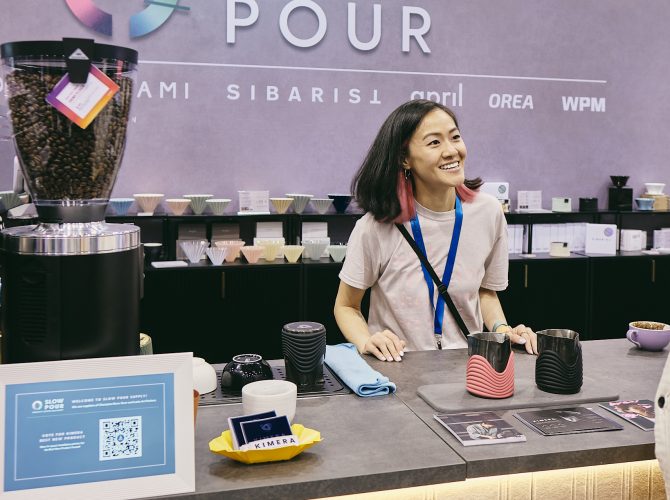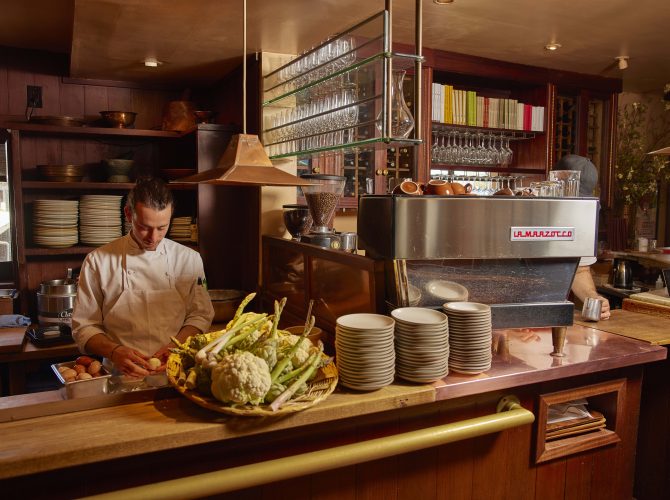In the first quarter of the last century, several attempts at manufacturing machines to make “espresso” coffee were carried out in Italy. They may rightfully be considered the progenitors of espresso machines in production today. They were equipped with hot water and steam generators, and tall vertical boilers.
The manufacturers, in addition to being skilled craftsmen, were pioneers considering the difficulties they faced at the time. Giuseppe Bambi was a member of this small group of pioneers. His strong personality and desire to create something of his own eventually led to establishing a small workshop and business.
After producing a few models called “Fiorenza” for a client, in collaboration with his brother Bruno, he began designing and building coffee machines independently. The Officina Fratelli Bambi was founded in 1927. In addition to designing the machines, they produced each part, and assembled and sold the machines during a period when any sale was a triumph. Indeed, Giuseppe Bambi adopted the symbol of the “Marzocco”, a seated lion with the crest of the Florentine Lily, synonymous with victory and triumph, and named his company La Marzocco.
With the arrival of fascism and a change in decorative styles, La Marzocco continued to produce machines with a vertical boiler, with a more linear and essential chassis.
The amount of coffee that people consumed was growing slowly but constantly, hence the need to improve the output of the coffee machines. On February 25th, 1939, Giuseppe Bambi registered a patent for a machine with a horizontal boiler, the first of its kind, with group heads arranged in a linear fashion. The horizontal boiler made it possible to add more group heads, as well as simplify the task of operating the machine.
WWII brought production to a halt. At the conclusion of the war, dim economical prospects and difficulty in procuring machinery and raw materials, forced La Marzocco to begin anew, yet the entrepreneurial spirit of the Bambi brothers led to the registration of a new patent in 1945, enabling the company to return to business as usual. The patent concerned a semiautomatic mechanism that simplified movements by the barista, and released pressure from the portafilter.
The 1950s were characterised by lever machines, which, through a spring activating a piston, pressed water through coffee at approximately 14 atmospheres. This technology not only modified the traditional method of percolating coffee, it transformed the taste. “Crema” entered the picture, becoming a standard in espresso coffee extraction overnight. To reduce the physical effort required by the barista, an electrically operated gear motor was added. This lead to the first machine with automatic water pressure and an electric motor.
In 1961, the company’s new headquarters were built in the hills overlooking Florence.
Following the flood that swept Florence in 1966, La Marzocco, although not directly affected, faced a complex economic situation since clients in the flooded areas were legally permitted to postpone payments, while the company had to continue to make its own. Patience and perseverance made it possible to move forward and in 1970, La Marzocco introduced the GS series.
The GS series proved to be revolutionary in light of the introduction of two, independent boilers, one for hot water and steam and the other for extracting coffee, the first machine of its kind in Italy and abroad. Independent boilers, which is standard technology in La Marzocco equipment still today, provides readily available steam or hot water without interfering with the temperature of the water used for coffee extraction. GS, in Italian, means “gruppo saturo” or saturated group. The brew groups were attached directly to the boiler and their shape was designed to create a chamber so that water circulates continuously, thereby maintaining constant temperature, a key factor in making top quality coffee.
The introduction of the GS was an immediate success in Italy and abroad, leading to a sort of legend. The GS series was followed by new designs and machines incorporating the original GS technology, including the GS-2, the Linea and the FB70.
Beginning in 1995, La Marzocco’s corporate structure was reorganized, including production, management and technical assistance. The company took on qualified technicians and bilingual personnel to promote business with foreign markets, and established a successful marketing and sales office in Milan, Italy.
From 2000-2008, La Marzocco was the official espresso machine sponsor of the World Barista Championship (WBC), the renown international coffee competition focusing on promoting excellence in coffee and advancing the barista profession.
The GB5 was introduced in 2005, followed by the FB/80 in 2006, and the one group GS3 in 2007, practically a domestic machine with professional technology. Each of these machines are equipped with PID temperature control, multifunction keypads and digital displays, reflecting innovations in the latest technology on the market.
The mechanical “paddle” configuration, originally launched with the GS series, was reintroduced in late 2008 on all standard machines and enables soft pre-infusion so the barista can bring out the best of espresso blends.
Ever mindful of its past, in 2009, following corporate restructuring, La Marzocco moved to new, improved facilities, 30 km north of Florence.
The Strada machine, whose ground-breaking first-ever technology, pressure profiling, was introduced in the early part of 2009 and includes input by a panel of leading baristas, technicians and market experts.The Vulcano grinder, uniting La Marzocco’s distinct design with Mazzer’s unparalleled technology, was introduced in Milan in October 2009.
In Spring 2013 the Linea PB, named for Piero Bambi who designed the Linea Classic and Linea PB, was introduced at the Boston SCAA conference. The Linea PB model refashions the Linea Classic and is distinguished by a new proprietary software platform which controls brewing time and volume, now also available with in-house scale technology.
The Vulcano Swift grinder is introduced in early 2014, with the Vulcano design and incorporating the Swift features such as the adjustable grind, dose and tamp technology, repeatability and consistency, high control level and minimum waste.
In Spring 2015, the company introduces a new machine specifically designed for the home espresso enthusiast: the Linea Mini. The innovative machine boasts Italian design at its best and is born from the iconic commercial espresso machine: the Linea Classic. The machine, with reduced footprint, presents the design and performance of a La Marzocco, including quality technological components, redesigned for the kitchen. With the Linea Mini, La Marzocco aims for an espresso revolution in the home.





